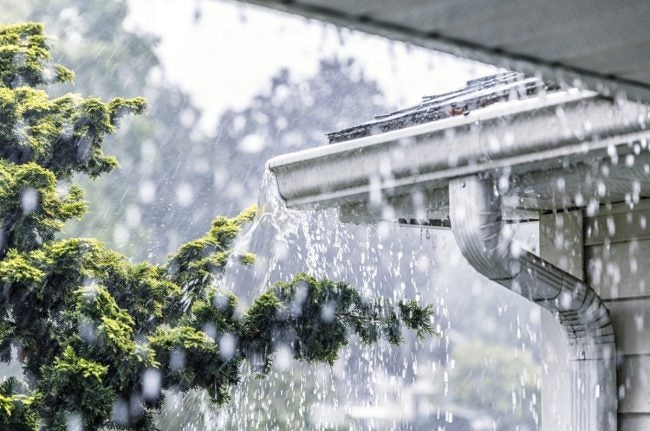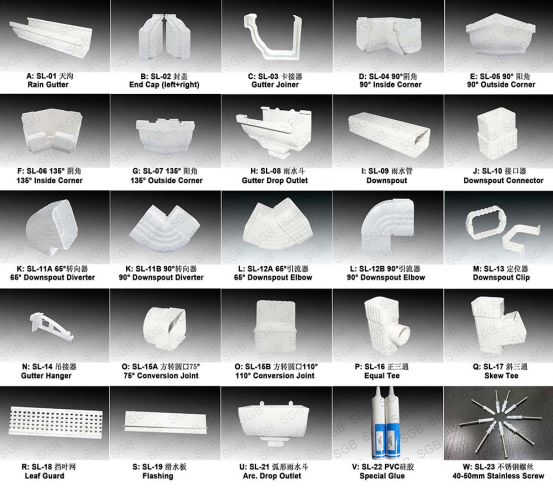THE LATEST IN ROOFING
Rain gutters, which run along the base of a roof, do more than keep downpours from drenching people as they come and go. By channeling water out and away from your home’s foundation, rain gutters reduce the risks of a flooded basement or damaged siding and minimize erosion and harm to your landscaping. What’s more, folks hoping to conserve water can direct runoff from gutters into a rain barrel to serve as a reservoir for the garden. Although rain gutters are simple structures, they come in a variety of configurations and are typically manufactured from five different materials—so whether it’s time to replace old and rusted gutters or you’re installing them for the first time, here’s what you need to know to make the best choice.

Are Gutters Always a Given?
First, figure out if your house really needs rain gutters. Most do, but there are exceptions, so consider the following:
If your roof has no overhang or only has a few inches of overhang, it’s likely that water will accumulate against the foundation, damage flower beds near the foundation, and/or pour down on people as they enter or exit your home. In this scenario, gutters are a must.
If your home has a sharply peaked roof with an overhang of 12 inches or more, rainwater will naturally tend to cascade out and away from the house, rather than dripping straight down to the ground to puddle against the foundation. In this case, gutters may not be necessary.
If your house is higher than the surrounding landscaping, water is unlikely to pool around the foundation, making gutters optional. But if the house is slightly lower than the surrounding ground, gutters are required to channel runoff a sufficient distance from the foundation.
If your house is completely surrounded by concrete in the form of patios, walkways, or driveways, rain gutters might be optional, as the concrete serves as a protective layer between the runoff and the foundation.
If you live in a very arid climate, you might opt out of installing rain gutters.
The Anatomy of Rain Gutters
As with most industries, the world of gutters has its own vocabulary and specific monikers for the various bits and pieces that comprise its workings. Learn more about the parts of gutters here.
Downspouts: This is part of the gutter that runs vertically down the side of the house, transporting water from the roof to the ground or collection vessel.
Downspout Elbow: The downspout elbow is an angled piece of downspout that fits at the bottom of the downspout and directs water away from the home’s foundation.
Pipe Cleats: Pipe cleats secure the downspout to the house.
End Caps: End caps fit to the end of a gutter length and seal off the gutter.
Hangers: Hangers are strips of metal that support the bottom of the gutter, preventing it from sagging.
Ferrule: Ferrules are a hollow shaft that encloses the long screw (also known as a “spike”) that attaches the gutter to the house.
Gutter: Gutters are sold in pieces of varying lengths. Each piece of gutter is called a “section”.
Mitered Corner: This is a corner piece of gutter that fits to the corner of the roof.

The Basic Rain Gutter Styles And Sizes
Rain gutters come in these three styles.
1. Half-round gutters, shaped like a tube cut in half, carry water very effectively.
Their open, trough-like shape makes them prone to leaf and debris clogs—the reason many homeowners choose to install leaf guards. Plus, their curved sides mean they don’t sit flush against the fascia boards, so generally, brackets are required to keep them in place. While half-round gutters aren’t particularly decorative, they are the traditional style found on homes built prior to 1960; if you live in an older neighborhood or in a historic home, local ordinances might require this type of rain gutter.
2. K-style rain gutters somewhat resemble the letter K when viewed from the side.
This is the most common type for homes built within the past 50 years, though many owners of older homes still install them today. Thanks to the flat back of the K-style gutter, you can nail it directly to the fascia board; no brackets required. But what really makes K-style gutters so popular is the typically decorative front side, which generally resembles crown molding. Thanks to their flat bottoms and straight, outwardly angled sides, K-style gutters usually can carry more water than half-round gutters, so they’re especially suited to rainy climates. On the downside, K-design gutters are a little harder to clean than half-round gutters, as the inner angles collect rotting debris.
3. Custom-built fascia gutters have a sleek, contemporary look.
Unlike K-style or half-round gutters, fascia gutters aren’t sold in sections that fit together, leaving seams that are prone to rust and leaks. Instead, fascia gutters are custom built for the house out of one long stretch of aluminum. Fascia gutters are pricey and must be professionally installed; you can pay as much as twice for them as half-round or K-style gutters, which you could install yourself. This can add up to hundreds of dollars, depending on the size of your home.



REQUEST A QUOTE
Copyright © Hangzhou Singer Building Materials Co., Ltd. All Rights Reserved |
Sitemap
| Powered by 
SEOKeywords:Roof Tile ManufacturerRoof Shingle ManufacturerAsphalt Shingle SupplierRain Gutter CompanyShingle Roofing CompanyWaterproof Tape For RoofPressed Steel Roofing TilesRain Gutter SystemGray Asphalt ShingleStone Coated Metal Roofing Manufacturer